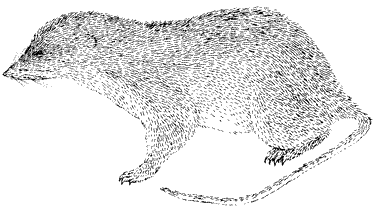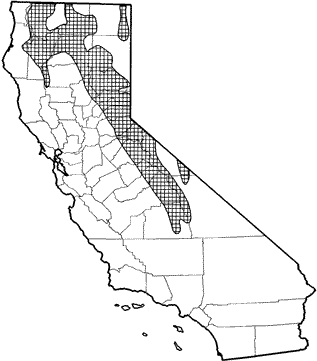
Water Shrew
Distribution, Abundance, and Seasonality
The water shrew is common to abundant in montane riparian habitats of the Cascades and Sierra Nevada from Siskiyou and Modoc cos. south to Tulare and Inyo cos. It is primarily restricted in habitat to cold mountain streams, their borders, and the borders of lakes (Hall 1946). It is also found in denser stages of mixed conifer, red fir, lodgepole pine, subalpine conifer, and eastside pine habitats immediately adjacent to riparian areas. Uncommon in a variety of other habitats as well (Bailey 1936, Conaway 1952, Ingles 1965, Thomas 1979), but rarely more than 30 m (100 ft) from water.

Range Map
Specific Habitat Requirements
Feeding: Forages along streambanks, water edges, and in the water; swims, dives, and searches stream bottoms and crevices. Eats aquatic insect larvae, small aquatic and terrestrial invertebrates, tadpoles, fish eggs, fish, carrion, and other shrews. Slugs and earthworms made up 49% of the stomach contents (Whitaker and Schmeltz 1973) in one study. May forage in decaying logs as well (Thomas 1979).
Cover: Logs, overhanging banks, dense streamside litter or vegetation, and rocky stream bottoms are used for cover.
Reproduction: Nests of moss, or other soft material, are built in secluded, protected banks or hollow, decaying logs near water (Ingles 1965). Most nests are within inches or feet of open water; none is over 30 m (100 ft) from open water (Conaway 1952).
Water: Drinks every 1-2 hr, but can endure over 6 hr without water. Can feed under ice-covered ponds (Ingles 1965, Beneski and Stinson 1987).
Pattern: Clear, cold streams are essential. Various forest and meadow vegetation may serve as cover (Conaway 1952), but never far from water.
Species Life History
Activity Patterns: Active day and night all year (Ingles 1965). Intermittent activity cycles with a 11/2 hr rhythm, in which 30 min are active and 60 min are inactive. There are 2 major peaks of activity every 24 hr: an hr before sunrise and between sunset and midnight (Sorenson 1962).
Seasonal Movements / Migration: None.
Home Range: Home range "small" and closely associated with a stream or wet area (Conaway 1952). Perhaps 1600 m (1 mi), or more, of stream required for a viable population (Thomas 1979).
Territory: Not territorial in Utah (Sorenson 1962), or in captivity (Conaway 1952).
Reproduction: Breeds from January to August, with peak from March or April to June or July. One, or more, litters of 5-8 young are born per year. Shrews generally live less than 2 yr (Ingles 1965, Thomas 1979).
Niche: Eaten by trout, mink, and birds of prey (Ingles 1965). Externally parasitized by mites in Minnesota (Whitaker and Schmeltz 1973, Whitaker et al. 1975).
Sources & References
California Department of Fish and Game, 1999.
California's Wildlife, Sacramento, CA.
Written by: V. Johnson, reviewed by: H. Shellhammer, edited by: R. Duke
Bailey, V. 1936. The mammals and life zones of Oregon. U.S. Dep. Agric., North Am. Fauna No. 55. 416pp. Beneski, J. T., Jr., and D. W. Stinson. 1987. Sorex palustris. Mammal. Species No. 296. 6pp. Conaway, C. H. 1952. Life history of the water shrew (Sorex palustris navigator). Am. Midl. Nat. 48:219-248. Hall, E. R. 1946. Mammals of Nevada. Univ. California Press, Berkeley. 710pp. Ingles, L. G. 1965. Mammals of the Pacific states. Stanford Univ. Press, Stanford, CA. 506pp. Sorenson, M. W. 1962. Some aspects of water shrew behavior. Am. Midl. Nat. 68:445-462. Thomas, J. W., ed. 1979. Wildlife habitats in managed forests: the Blue Mountains of Oregon and Washington. USDA, For. Serv., Agric. Handb. No. 553. 512pp. Whitaker, J. O., Jr., and L. L. Schmeltz. 1973. Food and external parasites of Sorex palustris and food of Sorex cinereus from St. Louis Co., Minnesota. J. Mammal. 54:283-285. Whitaker, J. O., Jr., G. S. Jones, and D. D. Pascal, Jr. 1975. Notes on mammals of the Fires Creek area, Nantahala Mountains, North Carolina, including their ectoparasites. J. Elisha Mitchell Sci. Soc. 91:13-17. Wrigley, R. E., J. E. Dubois, and H. W. R. Copland. 1979. Habitat, abundance, and distribution of six species of shrews in Manitoba, Canada. J. Mammal. 60:505-520.
California Animal Facts | California's Wildlife